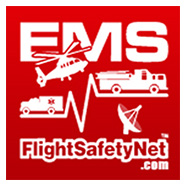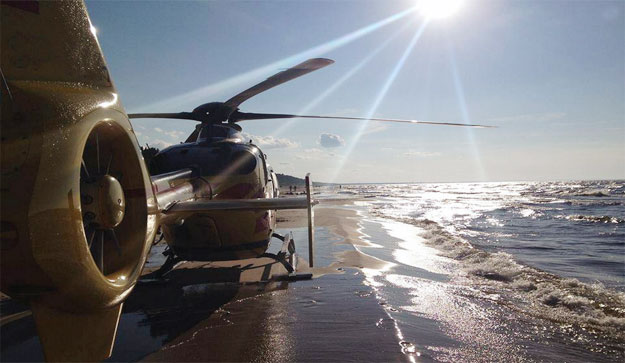Never heard of it, right?
You might even think I’m pulling your leg.
Honestly, I wish I was. I wish this entire post was just a tasteless joke written for my own amusement.
But it’s not.
The truth is Small Landing Zone Syndrome is real, although I’m just now coining the term. I’ve watched it spread for years, slowly but surely infecting thousands of EMS Flight Safety Network air and ground crews.
Not just clueless beginners, either. Smart firefighters, smart flight crews, smart EMTs & paramedics across the globe, all working hard to create safe medical helicopter landing zones, all doing everything they should be.
Except… none of it works for them.
Not because they’ve made a mistake. Not because their choices suck. Not because they’re lazy.
What Is Small Landing Zone Syndrome
What is small landing zone syndrome?
Small landing zone syndrome is a trap for EMS air and ground crews. Small landing zone syndrome is a sickness that puts air and ground crews at risk.
Small landing zone syndrome isn’t about the size of any one landing zone — although as you’ll learn shortly, size is one of the symptoms.
Small landing zone syndrome is about small thinking.
Why do smart crews fall prey to small landing zone syndrome?
Because they get comfortable.
They get used to doing things they way they’ve always done them.
Small landing zone syndrome is about thinking small. Thinking small instead of big. Thinking inside the box instead of out.
It’s like a sickness, quietly devouring their sanity, scene safety, and EMS flights until there’s nothing left.
And the scary part?
There’s a good chance you’ve caught the sickness too. After all, just how much focus are you giving to your landing zones?
Just a little? None at all?
That’s bad news, my friend. Ill tidings indeed.
The good news is Small Landing Zone Syndrome is curable. First though, we have to see whether or not you are infected.
Here are the symptoms:
Symptoms of Small Landing Zone Syndrome
1.) No Pre-planned Landing Zones
The tones drop and the call comes…
And for the 17th time this month you setup an impromptu landing zone as close as possible to the scene. Does this sound like your fire department?
Not a good plan. In fact, not a plan at all right?
Landing zones aren’t the time to “wing it.” Don’t get me wrong, every now and then an impromptu landing zone makes the most sense.
But impromptu landing zones should be the exception, not the rule.
Pre-planned landing zones are the foundation of safe landing zone programs. The more uncertainty you can remove from a time sensitive, emergency situation, the better.
Here is an easy checklist on how to pick a landing zone.
2.) No Ground-to-Air Communications Except Hand-held Radios
How does your fire department talk to inbound flight crews?
Are you trying to talk to inbound flight crews using a hand-held radio?
If yes, it’s time to consider upgrading your communications equipment. If you’re using portable radios in any type of hilly or mountainous terrain, you’re in for problems.
The flight crews will never come right out and say it, but it drives them crazy.
Why does using hand-held radios ground-to-air drive flight crews crazy?
Because flight crews want the same thing as ground crews. Land safely, pickup the patient safely, depart safely.
Using hand-held radios makes all of this a bigger challenge.
3.) No Pre-designated Frequency for Your Fire Department
Does your fire department have a pre-designated communication frequency?
Or are you using the primary frequency for the helicopter service you called?
If it’s the helicopter EMS primary frequency, and it’s a fairly busy multi-helicopter program, you can bet your landing zone report is stepping on top of other radio traffic.
And not just any radio traffic. Important radio traffic. Radio communications the flight crews need to hear.
And the really crap part is… you won’t even know it, because you can’t hear it from the ground.
What’s the solution?
Your own fire department frequency would solve this communication problem and others.
4.) No Landing Zone Training Within Last 12 Months
Setting up safe landing zones is a lot like flying helicopters.
It’s a skill.
Use it or lose it.
Don’t fall into the trap of familiarity and complacency. Even if you’ve been using the same pre-designated landing zone for years, you still need to train.
I recommend landing zone training at least once a year. If it’s possible to do more, do it.
When is the last time the local helicopter crew landed at your fire station and gave landing zone training? If it’s more than 12 months, it’s probably time to give them a call and get on their training calendar.
Professional flight teams look forward to the chance to educate you and the public about what they do. Don’t let any more time slip away. Give ‘em a call!
5). Nobody Qualified Except the Fire Chief
How many people in your fire department are qualified to setup a landing zone?
Qualified to setup a safe and good landing zone. A landing zone almost identical to how your chief would do it. It’s not rocket science, but it’s not easy either.
Practice is the key.
Set it up the same way every time. Then when you’re under the pressure of time constraints, you’ll simply fall back on the positive habits you developed during training.
The problem with only chief being qualified to setup helicopter landing zones is obvious. What happens when he’s not there?
Get as many people as possible qualified to setup your department’s medical helicopter landing zones. It makes good sense. It’s important to everyone (air and ground) to get it right. EMS pilots are a great resource. EMS pilots want to help you and your fire department. Here is an article about why EMS pilots love firefighters.
Hint: If you find the EMS pilot asking to talk with you (The Landing Zone Coordinator) one-on-one, and then find yourself getting all kinds of pointers and suggestions…
Yeah, you got the sickness and you need to find a cure.
6). No BIG Landing Zones
Do you know why flight crews tell ground crews landing zones should be 100 feet by 100 feet?
One primary reason.
100 is an easy number to remember.
That’s it!
100 is also a big enough space to land almost all makes and models of civilian EMS helicopters safely.
Here’s a fact I hope you’re not hearing for the first time:
“Bigger is better when it comes to helicopter landing zones. Size really does matter in certain situations, and this is one of them.”
As a landing zone coordinator, if you have the ability to pick big LZs over small LZs . . . all other things being equal, you should go big. Every time.
100 x 100 is an easy to remember guideline. Nothing more.
When I flew EMS, one of my recurring gripes was flying near-vertical approaches into extremely tight landing zones. The helicopter can do it, and I can do it. But why?
You can hold your breath for 78 seconds, right? But if there’s no reason to do it, don’t you prefer to just breathe normally?
See the point?
Keep it simple. Simple works.
Go big or go home. Big fixes a lot of the sickness.
7). No Follow Up
Nobody sits the bench in EMS Flight Safety Network.
Everyone works together — air and ground — to operate safely.
If your fire department isn’t getting feedback from local flight crews, something is wrong. And it needs your attention.
A simple phone call or email can solve a lot of issues.
Reach out. Follow up. Help.
The Cure To Small Landing Zone Syndrome
So what’s your deal?
Are you infected? Do you have the sickness?
It’s okay if you do. Small Landing Zone Syndrome isn’t terminal. It’s curable.
All you need is a mind shift away from small thinking, training and a positive attitude. Review the list above and ask yourself how you and your department can improve. It’s worth your time and effort. EMS Flight Safety Network crews (ground and air) deserve your attention. They’ve absolutely earned it.
Got a landing zone tip of your own? Share it in the comments section.
Sign Up for The Net Newsletter here (it’s free):
[shortcode-variables slug=”optin-form”]
Listen to the audio version here:


